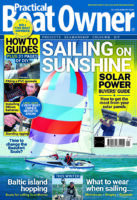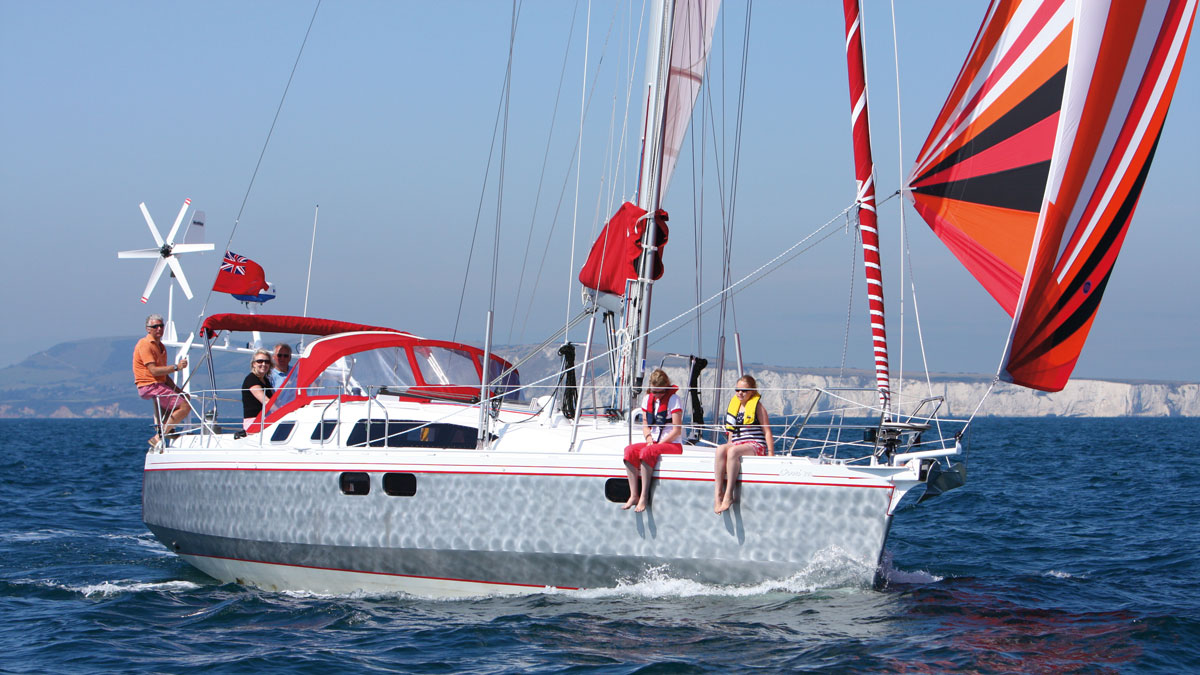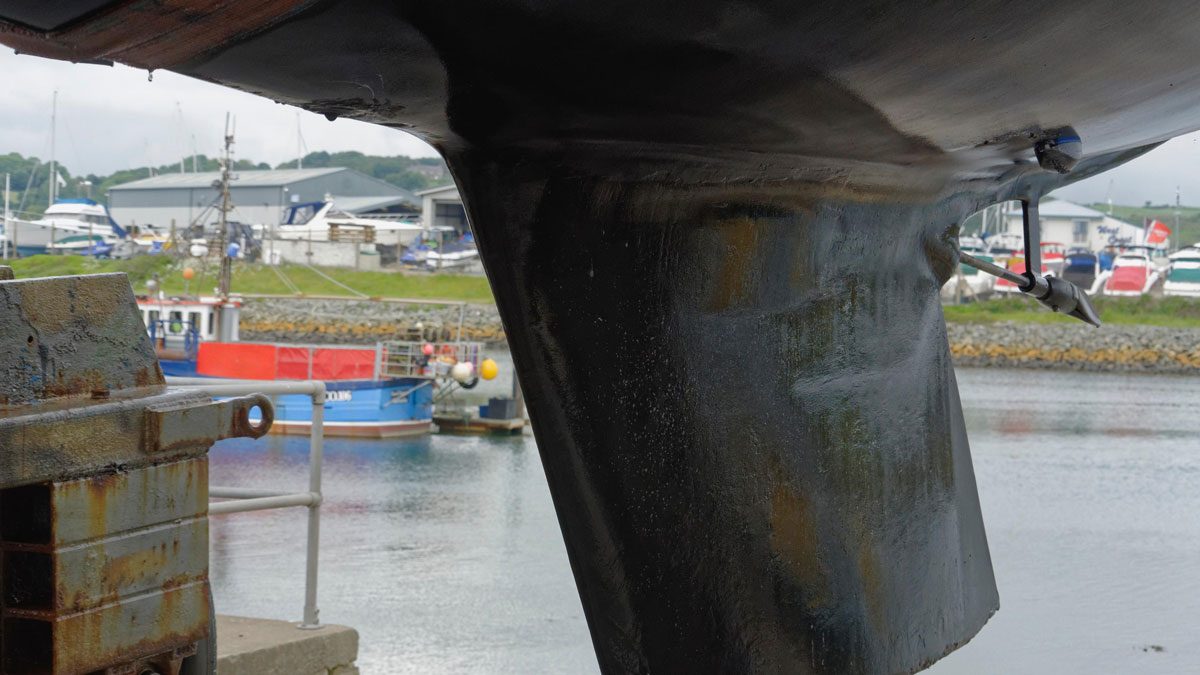Peter K Poland takes the helm of the French-built, aluminium-hulled cruising Allures 45 yacht
The Allures 45: crawl up creeks and dry out or cruise offshore
I wonder why aluminium-hulled cruising yachts built in the UK are so rare?
Take a trip across the Channel and you will find French examples of all shapes and sizes bobbing happily in most harbours – and those who cruise to more distant shores will find them there as well.
This is because many aluminium-hulled French cruisers and their owners like to chuck off their traces and sail across oceans.
There’s no logical reason for this shortage of UK-built aluminium yachts. High-quality and semi-custom production cruisers always have a place in niche markets, and British production builders have manufactured many excellent examples in GRP down the years.
Yet although the exceptional strength-to-weight ratio of an aluminium hull has never been in doubt, and this material has long been a favourite with blue-water sailors, the Brits have never competed in this field.
Examples of French multi-chine hulled aluminium Ovnis have appeared in the UK to fill this gap in the market – and more recently, Williams & Smithells has marketed a range of beautifully-built, round-bilged aluminium Allures cruisers over here.

The Allures 45’s twin rudders and flat bottom sections (with centreplate raised) mean she can sit on a beach. Credit: Allures
Allures 45 boat test
I was fortunate enough to sail two such yachts in Cherbourg – the Allures 45 and the dramatically different Exploration 45.
Allures Yachting is part of the Grand Large group that also includes the successful GRP Outremer catamarans and specialist aluminium boatbuilders Garcia.
These three companies offer very different products, but have one thing in common: they produce high-quality semi-custom craft that appeal to serious sailors.
The Allures are ‘dériveurs intégrals’ with substantial internal ballast and pivoting aluminium centreplates.
The current range – all designed by Berret-Racoupeau – includes the 39.9, 45 and 52.
I was impressed by the Allures 45’s production process when I visited their Cherbourg factory.
The aluminium hull and deck unit (fabricated elsewhere by sister company Garcia) is a well-made piece of work.
The aluminium plates are so skilfully rolled, welded and fettled into a round (as opposed to chined like an Ovni) hull that there is no filler. The finish is fabulously fair.
The skin thickness goes from 10mm on the bottom to 8mm just beneath the waterline to 6mm on the topsides.
The 5mm deck is welded to the hull for maximum strength at the join, and there’s additional thickness in areas like chainplate bases that need extra reinforcement.

An Allures 45 in build. Note stringers, forward watertight bulkhead and fair aluminium hull. Credit: Peter K Poland
An extensive web of aluminium stringers adds further strength and rigidity; a collision bulkhead is welded into the forward sections; and fuel and water tanks (550lt each) are fitted into the bilge where their weight will do the most good, along with the fixed ballast (4.4 tonnes out of an all-up weight of 11.8 tonnes).
Much of the interior fit-out is completed before the composite GRP coachroof is bonded and bolted into place.
Berret selected this material for the roof for several reasons: a stylish moulding makes for a more elegant shape than welded aluminium plates, reduces weight and maximises insulation.
As you would expect with any semi-custom cruiser, Allures offers many options and a fine finish.

The heads and shower compartments are aft. Credit: Peter K Poland
The Owner’s Version is aimed at small crews planning big voyages, featuring a large forecabin (with centreline double berth), a doubleberth cabin aft and a useful workshop to port. The heads and shower compartments are also aft.
The Cruiser Version has a forecabin (with en suite heads), two aft double cabins and a large heads plus shower cubicle aft.
Finally, the Family Version offers an extra ‘passage berth’ cabin (to port) aft of a forward V-berth cabin.
There are also other options such as generator, watermaker, extra electronics, extra refrigeration et al.
Owners optimise these boats to suit their needs, be they ocean voyaging or coastal pottering.
Serious voyaging

The chart table area including stowage etc, saloon and linear galley, forepeak berth. Credit: Peter K Poland
As I took in the test yacht’s ‘ambience’ and quality cherry woodwork down below, it was obvious that this is no run-of-the-mill mass-produced yacht.
The linear galley runs along the port side (with lockers and drawers aplenty) while the saloon settees and dining table are to starboard.
The centreline settee hides the centreplate housing with an inspection panel for checking the lifting tackle. Robust stainless steel grab handles fall easily to hand.
The navigation area is to starboard featuring a big table with stowage inside, an adjustable forwardfacing seat and useful drawers for charts and other sundry gear.
It’s all obviously designed for serious voyaging.
And while on the subject of storage, the Allures 45 squirrels away almost 12,000lt of locker space, compared to the 8,500lt typically found on a yacht of this size and type.
Up on deck, the cockpit is comfortable and secure with twin-wheel steering, well-proportioned seats and deep backrests.
The teak cockpit table acts as a convenient foot brace and has storage space inside.
This example was fitted with a beautifully-made sprayhood and bimini that stowed away against the multi-function arch over the back of the cockpit.
Every detail is carefully thought out and well executed. Before setting sail, I asked the boat’s owner why the Allures 45 had topped his shopping list.
‘We could have spent less on an average GRP yacht, but we wanted something special,’ he replied. ‘The aluminium construction, shallow-draught ability, beautiful finish and flexibility on the specification added up to a tailormade yacht. And she’s beautiful.’
Leaving the quay, the 55hp Volvo was whisper-quiet. As on any twin-rudder yacht, astern steerage took time to ‘bite’ when reversing out, but there was a bow thruster if needed (which it wasn’t).
Under way, the feathering three-bladed prop provided plenty of push, giving 5 knots at 1,500rpm, 6 knots at 1,800rpm and 8 knots at 3,000rpm.
Once outside, the fully-battened mainsail went up without catching on the lazyjacks – which makes a change.
Allures sensibly leads these down via a point halfway along the spreaders, which widens the gap.
In the lightish breeze, we unrolled the Solent headsail rather than the smaller staysail that sets inboard on its dedicated inner forestay and roller.
This cutter rig adds to the cost, but you have the benefit of different-sized headsails to suit differing conditions.
The standard sails were of high quality, as befits a boat designed to travel far.
Unlike mass-production builders, Allures doesn’t cut corners.
With the 180kg NACA section centreplate lowered (operated from the cockpit by an electric winch), the draught increases from 1.05m to 3m – so there’s plenty of bite.
She went upwind at 6.8 knots, tacking through less than 90 with the wind at 12 knots.
The helm felt balanced and the motion was easy as 11.8 tonnes of yacht slipped effortlessly through the sea.
She is not a race boat, and tacking a cutter can take longer: but this Allures is a pleasure to sail and will eat up sea miles with comfortable ease.
The Allures 45 slides safely sideways

A detail of the Allures 45’s neat hatch stowage. Credit: Peter K Poland
Being a centreplate yacht with internal ballast, a reef is tucked in at about 18 knots true upwind.
Owners’ experiences prove that these yachts take heavy weather in their stride – and with the plate raised, they will slide safely sideways in storm-tossed seas, whereas deep fin-keelers can be prone to tripping and pitchpoling.
Once in open sea, we set the large nylon gennaker.
This lives on a continuous-line Profurl furling system. Having tacked the sail onto the front of the bowsprit, we hoisted the furled ‘sausage’ and put plenty of tension into the luff, keeping it straight and taut.
As a result, we could set it with the wind ahead of the beam.
With a true wind of just 10 knots, the Allures 45 surged along at an impressive 7.5 knots.
This is a versatile and distinctive yacht. With its plate raised, you can crawl up creeks and dry out: then you can cruise offshore in comfort and security.
Of course, it’s high quality doesn’t come cheap, but you get what you pay for in this life.
With the Allures 45, this amounts to a variable-draught aluminium-hulled blue water cruiser that can be custom-built to suit your needs.
Several sailors have decided it’s worth every euro.
Tech spec: Allures 45
Price: Standard Allures 45 ex-Cherbourg: €334,350 ex-VAT
Length: 13.98m
Gennaker: 82m2
Maximum beam: 4.43m
Spinnaker: 125m2
Draught: 1.05-3.00m
Offshore category: 8 persons
Displacement: 11.8 tonnes
Onshore category: 10 persons
Air draught: 19m Engine: 55/75hp
Mainsail: 55m2
Architect: Berret-Racoupeau/ Franck Darnet Solent: 45m2
Contact: www.allures.fr
UK dealer: Williams & Smithells
Ovni 395: aluminium all-star
She can dry out on the beach, cross oceans, and bounce off submerged dangers that would present a serious threat…
Offshore boats: the best power and sailing yachts to take you further afield
Want to go further afield? Duncan Kent looks at some of the most suitable second-hand sail and motor boats for…
Why are boat owners being urged to switch to aluminium anodes?
Boat owners and boatbuilders across the UK are being urged to switch from zinc to aluminium anodes to help marine…
Want to read more boat test articles?

A subscription to Practical Boat Owner magazine costs around 40% less than the cover price.
Print and digital editions are available through Magazines Direct – where you can also find the latest deals.
PBO is packed with information to help you get the most from boat ownership – whether sail or power.
-
-
-
- Take your DIY skills to the next level with trusted advice on boat maintenance and repairs
- Impartial, in-depth gear reviews
- Practical cruising tips for making the most of your time afloat
-
-
Follow us on Facebook, Instagram, TikTok and Twitter







